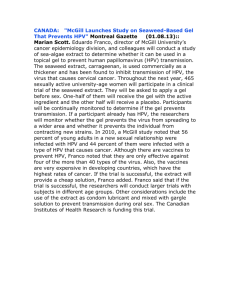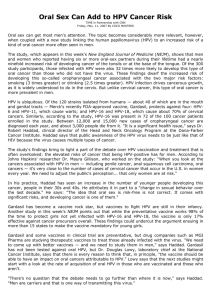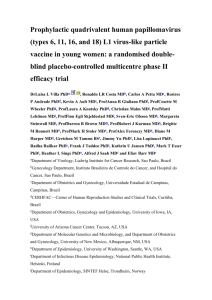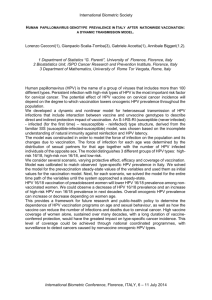An evaluation of Qiagen HPV sign for the detection and genotyping
advertisement
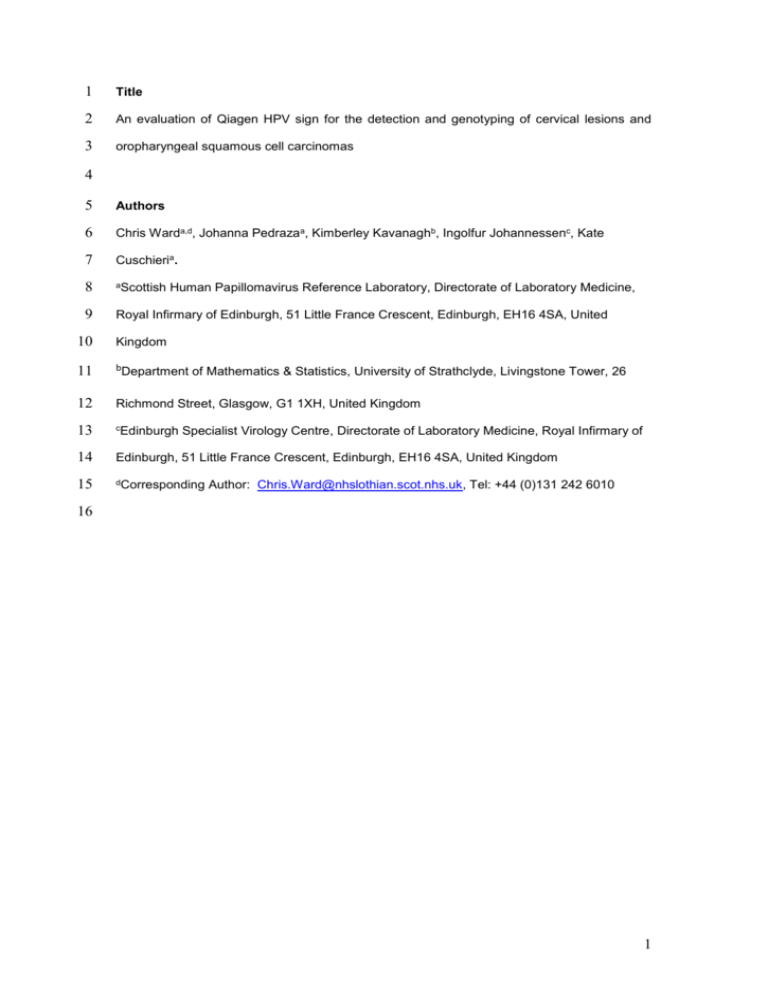
1 Title 2 An evaluation of Qiagen HPV sign for the detection and genotyping of cervical lesions and 3 oropharyngeal squamous cell carcinomas 4 5 Authors 6 Chris Warda,d, Johanna Pedrazaa, Kimberley Kavanaghb, Ingolfur Johannessenc, Kate 7 Cuschieria. 8 aScottish 9 Royal Infirmary of Edinburgh, 51 Little France Crescent, Edinburgh, EH16 4SA, United Human Papillomavirus Reference Laboratory, Directorate of Laboratory Medicine, 10 Kingdom 11 bDepartment 12 Richmond Street, Glasgow, G1 1XH, United Kingdom 13 cEdinburgh 14 Edinburgh, 51 Little France Crescent, Edinburgh, EH16 4SA, United Kingdom 15 dCorresponding of Mathematics & Statistics, University of Strathclyde, Livingstone Tower, 26 Specialist Virology Centre, Directorate of Laboratory Medicine, Royal Infirmary of Author: Chris.Ward@nhslothian.scot.nhs.uk, Tel: +44 (0)131 242 6010 16 1 17 Abstract 18 HPV genotyping is an important tool in the epidemiology and surveillance of HPV associated 19 cancers and for the risk-stratification of HPV infections. HPV sign Genotyping Test (QIAGEN) 20 is a new pyrosequencing assay for the detection and genotyping of HPV. The sensitivity and 21 comparative performance of HPV sign was determined using a sample panel derived from 22 histologically confirmed cervical lesions (cervical intraepithelial neoplasia 2 or worse) and 23 oropharyngeal squamous cell carcinomas. Comparative analysis showed that 80% of cervical 24 intraepithelial neoplasia 2+ and 81% of oropharyngeal squamous cell carcinomas were HPV 25 positive by HPV sign compared to 100% of the cervical intraepithelial neoplasia 2+ and 81% 26 of oropharyngeal squamous cell carcinomas by the digene HPV Genotyping RH Test (RH), 27 and INNO-LiPA HPV Genotyping Extra assay respectively. Fewer genotypes were detected 28 overall by HPV sign than via the relevant comparator assays (10 v 21 for cervical 29 intraepithelial neoplasia 2+; 4 v 9 for oropharyngeal squamous cell carcinomas) and also 30 fewer multiple infections (9 v 28 for cervical intraepithelial neoplasia 2+; 0 v 4 for 31 oropharyngeal squamous cell carcinomas). HPV sign results were more compatible with the 32 comparator assay for the oropharyngeal squamous cell carcinoma samples (100%) than for 33 the cervical samples (73%). These results suggest that HPV sign in its current form is suited 34 to samples that harbour multiple infection. 35 Key Words 36 HPV, pyrosequencing, genotyping, cervical, oropharyngeal squamous cell carcinoma 37 38 1. Introduction 39 Persistent infection with a high-risk HPV type is necessary for the development of certain 40 anogenital cancers including cervical cancer (Walboomers et al. 1999), HPV infection is 41 associated also with an increasing proportion of Oropharyngeal Squamous Cell Cancers 42 (van 43 12 HPV types have been characterised as class I carcinogens for humans, and several other 44 HPV types classed as possibly carcinogenic to humans, by the International Agency for 45 Research on Cancer (IARC 2012). HPV genotyping is vital for epidemiology and surveillance 46 of HPV, particularly given the introduction of immunisation programmes. Genotyping may also Monsjou et al. 2010) with HPV positivity indicating an improved prognosis. Currently 2 47 have an increasing role in the risk stratification of infection for HPV associated disease 48 management (Khan et al 2005). 49 50 Currently there are more than 100 commercially available HPV assays (Cuschieri 2011, 51 Poljak et al. 2012) with output results ranging from limited typing of HPV 16 and 18 (e.g. 52 cobas® HPV Test (Roche) and the Real Time High Risk HPV Test (Abbott) through to middle- 53 range typing of 12 to ~35 types via reverse line blot assays to multiplex detection of >80 types 54 such as the Origene Luminex Multiplex system (Schmitt et al. 2011). 55 technology offers a new approach to HPV detection that potentially broadens the ability to 56 detect rare or novel virus genotypes (Barzon et al. 2011). Pyrosequencing 57 58 HPV sign Genotyping Test (HPV sign) (QIAGEN, Hilden, Germany) adapts pyrosequencing 59 technology to HPV diagnostics and genotyping, however data on clinical performance is 60 limited : Barbieri et al. (2012) in an analysis of 87 archived DNA extracts from cervical 61 biopsies (34/87) and cervical swabs (53/87) found HPV sign had a lower sensitivity (61% v 62 69%) and ability to detect multiple infection compared to historical INNO-LiPA HPV 63 Genotyping Extra assay (INNO-LiPA) (Innogenetics NV, Ghent, Belgium) data; one further 64 study used HPV sign to screen cervical samples from attendees at a colposcopy unit, 65 detecting HPV DNA in 50.5% in these patients (Paba et al. 2012). 66 67 A key performance attribute of any clinically orientated HPV assay is sensitivity for the 68 detection of high-grade cervical lesions. Key performance attributes of an assay orientated to 69 epidemiology and surveillance are an ability to delineate multiple infections and amenability to 70 diverse bio-specimens. Thus, the objective of this study was to consolidate and enhance the 71 performance data on HPV sign using an enriched panel of previously annotated samples 72 associated with 73 carcinomas. cervical intraepithelial neoplasia 2+ and oropharyngeal squamous cell 74 75 2. Study Design 76 2.1 Sample Selection 3 77 The present study utilised archived, previously annotated nucleic acid (NA) collected as a 78 result of either National HPV Immunisation Surveillance or routine/referral and audit 79 associated with the services provided by the Scottish HPV Reference Laboratory. In total 100 80 clinical extracts collected within Scotland were assessed by HPV sign. Samples come under 81 the NHS Lothian ‘Safe Haven’ for tissue research (NHS Lothian SAHSC Human 82 BioResource:08/S1101/41 and 10/S1402/33) 83 84 The cervical cases consisted of NA derived from 47 cases of cervical intraepithelial neoplasia 85 2 and 32 cases of cervical intraepithelial neoplasia 3 (i.e. 79 cases of cervical intraepithelial 86 neoplasia 2+) diagnosed in Scotland in 2005 and stored as formalin fixed paraffin embedded 87 (FFPE) blocks as per routine practice. 10 micron sections were taken from the original FFPE 88 block and stored at room temperature prior to extraction. NA was extracted in 2009 using an 89 adaptation of the QIAamp DNA Mini Kit (QIAGEN) optimised for FFPE sections (Steinau 90 2011) and all cases were genotyped using the digene HPV Genotyping RH Test (QIAGEN). 91 Residual NA had been stored at -80°C and subject to only 1 freeze thaw cycle before the 92 present analysis. 93 94 In addition a total of 21 NA extracts derived from oropharyngeal squamous cell carcinoma 95 samples were assessed. Cases had been received and extracted over a period 96 encompassing 2009-11 with the extraction methodology as above. All 97 squamous cell carcinomas had been tested previously using the INNO-LiPA assay. Residual 98 NA had been stored at -800C and had not been subject to any freeze thaw cycle before the 99 present analysis. oropharyngeal 100 101 2.2 HPV Genotyping 102 The HPV sign Genotyping Test (QIAGEN) was performed according to the manufacturers’ 103 instructions. HPV sign uses EVA Green real-time PCR with primers for the hypervariable 104 region of the HPV L1 ORF to amplify DNA from a broad range of HPV types using the Rotor 105 Gene Q. Primers against human beta-globin are included to provide a control for 106 cellularity/inhibition. The presence or absence of HPV DNA is determined by melting curve 4 107 analysis. Samples determined to be HPV positive on the melt curve are advanced to 108 pyrosequencing using the Pyromark Q24 with 4 specific sequencing primers recognising HPV 109 31-like, HPV 16-like, HPV 39-like, and a broad spectrum of HPV types, for the generation of 110 sequence data. HPV types are identified from the sequence data using the IdentiFire version 111 1.0.5.0 software package (Biotage AB, Uppsala, Sweden). 112 113 Samples which tested as “no template” (NT) with HPV sign, or which had HPV sign 114 genotyping results incompatible with the archived data from comparator assays, were 115 retested with HPV sign at a 1/10 dilution of template to mitigate the effect of pcr inhibitors 116 potentially present in the sample. 117 118 The research use only (RUO) RH (QIAGEN) incorporates a polymerase chain reaction stage 119 using GP5+/6+ primers to amplify a region of the HPV L1 ORF. Amplicons are then 120 hybridized to strips with 18 immobilized probes corresponding to all currently known high-risk 121 HPV genotypes and probable high-risk HPV genotypes (16, 18, 26, 31, 33, 35, 39, 45, 51, 52, 122 53, 56, 58, 59, 66, 68, 73, 82). This version of the assay does not contain an internal control 123 for sample adequacy. 124 125 INNO-LiPA uses SPF10 modified primers to PCR amplify a 65bp region of the HPV L1 ORF 126 with human HLA-DPB1 primers used as an internal control for template quality. Amplicons are 127 used as probe in a reverse line blot hybridization against DNA sequences from 18 high-risk 128 and probable-high risk HPV genotypes listed above and an additional 10 HPV genotypes (6, 129 11, 40, 43, 44, 54, 69, 70, 71,74). 130 131 2.3 Data Analysis 132 A simple HPV positivity rate was determined for each assay and sample type, with cervical 133 results stratified into cervical intraepithelial neoplasia 2 and cervical intraepithelial neoplasia 134 3. Concordance of genotyping results was assessed for HPV sign v. RH (cervical 135 intraepithelial neoplasia 2+), and HPV sign v. INNO-LiPA (oropharyngeal squamous cell 136 carcinoma samples). Individual genotyping results were considered to be (i) fully concordant 5 137 where an identical list of HPV genotypes was obtained by each assay; (ii) partially concordant 138 where at least one genotype in common was assigned by each assay but where full 139 concordance did not occur; and (iii). non-concordant (incompatible) where either the sample 140 tested as positive by one assay but negative by another, or where there was no overlap in the 141 genotypes assigned by each assay. 142 143 Assay specific counts were taken for the occurrence of specific HPV genotypes within the 144 cervical and 145 stratified into mono v multiple infections for : (i) all positive samples; (ii) all high-risk HPV 146 types (see above); (iii) specific high-risk HPV genotypes of particular interest to immunisation 147 surveillance (HPV 16, 18, 31, 33 and 45). Kappa values (Cohen 1960) and associated 95% 148 confidence intervals were calculated as a measurement of agreement between HPV sign v 149 RH (cervical samples), and HPV sign v INNO-LiPA (oropharyngeal squamous cell 150 carcinomas). oropharyngeal squamous cell carcinoma sample sets. HPV detection was 151 152 3. Results 153 3.1 Cervical Samples 154 3.1.1 Overall HPV Positivity of cervical intraepithelial neoplasia 2+ by HPV sign 155 Of the 79 cervical biopsies associated with cervical intraepithelial neoplasia 2+, the Rotor 156 Gene Q identified 61 samples as HPV positive (77.2%), and these were advanced to 157 pyrosequencing stage as per the manufacturer’s algorithm. It was notable that only one 158 sample gave a positive result for the template control (human beta-globin) in the Rotor Gene 159 Q analysis. 160 161 A positive genotyping result was obtained from 59/61 pyrosequencing reactions, giving an 162 overall HPV positive rate of 75% (95% CI: 64%, 83%) by HPV sign in the cervical 163 intraepithelial neoplasia 2+ panel. Follow up HPV sign testing of initially HPV negative 164 samples (n = 20) at 1/10 dilution resulted in a further four positive genotyping results, 165 increasing the HPV positivity rate to 79.7% (95% CI: 70%, 87%). The HPV positive rates were 166 similar for cervical intraepithelial neoplasia 2 (80.9% CI 67.5%, 89.6% n= 47) and cervical 6 167 intraepithelial neoplasia 3 (78.1% CI 61.2%, 88.9% n= 32). All of these samples had tested 168 previously as HPV positive by RH. 169 170 3.1.2 Type specific concordance RH vs HPV sign in cervical intraepithelial neoplasia 2+ 171 There was full concordance between the RH and HPV sign genotyping results for 38% (95% 172 CI: 28%, 49%) of the cervical samples with a further 35% (95% CI: 26%, 46%) of results 173 displaying partial concordance i.e. at least one HPV type detected in common. For 21 174 samples (26%, 95% CI: 18%, 37%) the RH and HPV sign results were incompatible. In 16 of 175 these cases the sample tested as HPV positive by RH, but HPV negative by HPV sign, this 176 including one instance of HPV 16, one instance of co-infection with HPV 18 and HPV 51, and 177 five instances of HPV 31. The 5 remaining cases tested as HPV positive by both RH and 178 HPV Sign, however non-overlapping sets of genotypes were identified by RH and HPV Sign 179 (Table 1). 180 181 The RH results describe a more complex population of HPV types (21 HPV types, 79 positive 182 results, 28 multi-type infections with up to 4 co-infection types) compared to the HPV sign 183 results (10 HPV types, 63 positive results, 9 mixed infections with a maximum of two types 184 within a sample (Tables 2 & 3). 185 186 The genotypes identified most frequently by RH were HPV 16, 18, 33 and 31. HPV sign 187 detected similar numbers of HPV 16, 18 and 33, but notably fewer cases of HPV 31 (13 cases 188 v 2 cases for RH and HPV sign respectively). Table 2 shows the occurrence of selected high- 189 risk HPV types in both mono- and multiple infections as measured by each assay. Overall, 190 73/79 (92%) cervical samples were positive for high-risk HPV types (HPV 16, 18, 31, 33, 35, 191 39, 45, 51, 56, 58, 59 and 68) by RH, compared to 57/79 (72%) samples by HPV sign (Table 192 2). 193 194 35% of samples testing positive by RH contained >1 HPV genotype, including 5 samples 195 which contained 4 co-infecting HPV types. However only 14% of HPV sign positives 196 contained multiple types and no more than 2 HPV types were identified from a single sample. 7 197 Kappa values for HPV sign v RH are considered substantial (Landis JR, Koch 1977) for HPV 198 16, 18, 31 and 33, but only fair for HPV 45, and poor for “all high-risk HPV” (Table 2). A full 199 listing of genotypes obtained from individual cervical samples is provided in supplementary 200 table S1. 201 202 3.2 Oropharyngeal squamous cell carcinomas samples 203 3.2.1 Overall HPV positivity of oropharyngeal squamous cell carcinomas by HPV sign 204 Twenty-one oropharyngeal squamous cell carcinoma samples tested previously by INNO- 205 LiPA HPV Genotyping Extra Test were selected for analysis by HPV sign. Seventeen (81%) 206 had tested HPV positive by INNO-LiPA. HPV sign identified 15 cases of HPV, rising to 17 207 (81% HPV positivity) following reanalysis of initially HPV negative samples at 1/10 dilution. 208 The same subset of 209 positive by INNO-LiPA and HPV sign. oropharyngeal squamous cell carcinomas samples tested as HPV 210 211 3.2.2 Type specific concordance RH vs HPV sign in oropharyngeal squamous cell 212 carcinomas 213 RH and HPV sign genotyping results for oropharyngeal squamous cell carcinoma samples 214 were 100% compatible following two rounds of HPV sign testing (neat sample and 1/10 215 dilution), with full agreement achieved in 81% (19/21) of samples. Restricting analysis to the 216 HPV sign performed on neat samples yields 2 discordant results (9.5%), both of which were 217 HPV 16 positive by INNO-LiPA but HPV negative by HPV sign (Table 1). 218 219 Fewer HPV types were identified in the oropharyngeal squamous cell carcinoma samples 220 than in the cervical samples, with a total of 9 HPV types identified by INNO-LiPA, and 4 by 221 HPV sign (Table 3). As expected, HPV 16 dominated results from both assays, being present 222 in 57% of samples by both INNO-LiPA and HPV sign. 223 224 None of the oropharyngeal squamous cell carcinoma samples contained more than a single 225 genotype according to HPV sign, however the RH assay identified 4 incidences of multiple co- 226 infecting HPV types. The small number of oropharyngeal squamous cell carcinoma samples 8 227 and the limited heterogeneity of types, limits the use of the Kappa statistic, particularly for 228 individual HPV types. 229 oropharyngeal squamous cell carcinoma samples is given in supplementary table S2. A full description of the individual genotypes obtained from 230 231 Internal template control results were consistently negative for all oropharyngeal squamous 232 cell carcinoma samples for both INNO-LiPA and HPV sign whether tested as neat sample or 233 at a 1/10 dilution. 234 235 4. Discussion 236 In this study, a sample set of DNA extracted from 79 cervical intraepithelial neoplasia 2+ 237 biopsies which had tested previously as HPV positive by the RH assay were tested using the 238 new HPV sign genotyping assay. HPV sign performed on undiluted samples detected and 239 assigned an HPV genotype in 59/79 (75%) of cases, rising to 63/79 (80%) upon re-analysis of 240 initially negative samples at 1/10 dilution. There was no significant difference in the detection 241 rates for cervical intraepithelial neoplasia 2 and cervical intraepithelial neoplasia 3 samples 242 using HPV sign. For an HPV assay to be clinically applicable - a sensitivity of 90% for cervical 243 intraepithelial neoplasia 2+ (relative to a gold standard assay) is suggested and according to 244 these data HPV sign falls just below this threshold. 245 246 A smaller range of HPV types and fewer multi-type infections were detected by HPV sign 247 compared to RH in the cervical intraepithelial neoplasia 2+ samples. Further, HPV sign 248 detected a maximum of two co-infecting HPV types, compared to four with RH, and never 249 more than one type from within one of the four pyrosequencing channels used in the 250 Pyromark Q. Certain HPV types were identified less often by HPV sign than by RH, notably 251 the high-risk types HPV 31, 52 and 56 (Table 3), Approximately one-third of cervical 252 genotyping results were in full concordance between HPV sign and RH, with a further third of 253 samples giving compatible (partially concordant) 254 incorporate any cervical intraepithelial neoplasia 2+ that tested negative for HPV by RH. 255 Although, 256 intraepithelial neoplasia 3+) are rare, it is possible that concordance between HPV sign and HPV negative cervical intraepithelial results. The study population did not neoplasia 2+ (particularly cervical 9 257 RH results may be higher in a sample which includes HPV negative biopsies; consequently 258 HPV sign may be disadvantaged in this respect. 259 260 For the oropharyngeal squamous cell carcinoma samples 100% concordance between RH 261 and HPV sign results was reached at the qualitative level when neat and diluted sample 262 results were aggregated for the latter. The initial round of HPV sign testing on neat samples 263 yielded an HPV detection rate of 88% for the 264 samples, this is higher than the 74.7% observed with the cervical intraepithelial neoplasia 2+ 265 samples. oropharyngeal squamous cell carcinoma 266 267 As in the cervical samples, HPV sign identified a narrower range of HPV types in the 268 oropharyngeal squamous cell carcinoma samples than did the comparator line blot assay. 269 None of the oropharyngeal squamous cell carcinoma samples contained more than one HPV 270 genotype according to HPV sign. Concordance and kappa scores for HPV sign v INNO-LiPA 271 were much higher than for HPV sign v RH in the cervical samples, indicating that in its current 272 form HPV sign may be suited more to sample types that are less likely to contain multiple 273 infections. 274 275 The internal control for sample adequacy in both INNO-LiPA (no positives from twenty-one 276 samples) and HPV sign (one positive result from seventy-nine samples) performed poorly in 277 this study, which is in contrast to the internal control for the Luminex HPV assay which has 278 been shown to perform well with FFPE material (Schmitt et al. 2011). 279 concern in the clinical setting as the absence of a reliable cellular control makes it impossible 280 to distinguish a true negative result from an inadequate reaction. 281 methods section, nucleic acid extraction was performed using a technique optimised for FFPE 282 material and a kit that is provided by the same manufacturers of the HPV sign assay 283 (Qiagen). Consequently, we would suggest that extraction technique is unlikely to have had a 284 significant impact on internal control performance. Re-consideration of the detection cut-for 285 the existing internal control or reselection of an alterative target sequence may be warranted. This is a particular As described in the 286 10 287 There are limitations to this study; the absolute number of samples is relatively small, 288 although, all samples were either cancerous (oropharyngeal squamous cell carcinomas), or 289 high-grade lesions (cervical intraepithelial neoplasia 2+), .However, enriching for high grade 290 lesions at least allows for a robust assessment of sensitivity - a key attribute of any clinically 291 orientated HPV test. Furthermore this study was not a true head to head; sampling, extraction 292 and testing of the different assays was not performed at the same time and in this way the 293 HPV sign was disadvantaged. However, DNA stored at -800C has been shown to be stable 294 for HPV detection, in a study where DNA had been stored for 8 years at -80 and subject to 5 295 freeze thaw cycles, high recovery and concordance for type specific HPV detection was 296 observed (95%) ( Cuschieri 2008). 297 298 To conclude, the data suggest that further calibration of HPV sign to disease endpoints may 299 be justified if it is to be considered for use in cervical disease management. In terms of its use 300 for epidemiological work, the diversity and extent of multiple infection was lower compared to 301 the comparator line blot assays. The higher concordance of HPV sign for the oropharyngeal 302 squamous cell carcinoma cases (compared to cervix) which harbour fewer types (and 303 diversity) indicates that it may be more suitable for samples that contain fewer infections, at 304 least in its current form. One possible advantage of HPV sign that was not addressed in this 305 study is its potential to detect rarer and/or cutaneous HPV types which are not incorporated 306 into other HPV commercial assays. This latter feature may make HPV sign a good choice for 307 investigative work in less established disease contexts and further work in this area would be 308 of value. 309 310 5. Acknowledgements 311 We thank QIAGEN for the supply of HPV sign kits for this study. 312 313 6. Conflict of Interests 314 Qiagen provided the consumables and equipment required to perform HPV SIGN gratis, 315 however, analysis and interpretation of the data was performed independently 316 11 317 7. References 318 319 Barbieri D, M Nocera, G Gallinella et al . Comparison of HPV sign Genotyping Test with 320 INNO–LiPA HPV Genotyping Extra assay on histologic and cytologic cervical specimens. 321 Diagn Micr Infect Dis 2012;74,43–8 322 323 Barzon L, E Lavezzo, V Militello, et al. 324 Technologies to Diagnostic Virology. Int Journal of Mol Sci 2011,12: 7861–84 Applications of Next–generation Sequencing 325 326 Cohen J. A coefficient of agreement for nominal scales. Educ Psychol Meas 1960;20, 37–46 327 328 Cuschieri K. 329 Presented at 8th International Multidisciplinary Congress of the European Organisation for 330 Genital Infections and Neoplasia, November 2008, Nice (ss 5-7) Monitoring trends in HPV diversity - Making the most of existing archives. 331 332 Cuschieri K . Human papillomavirus testing: the challenges of picking the right tools for the 333 job. Expert Rev Obstet Gynecol 2011;6:1 – 11 334 335 IARC Working Group on the Evaluation of Carcinogenic Risks to Humans. A review of human 336 carcinogens. IARC Monogr Eval Carcinog Risks Hum. 2012;100(Pt B):1-441 337 338 Khan MJ, Castle PE, Lorincz AT et al. The elevated 10-year risk of cervical precancer and 339 cancer in women with human papillomavirus (HPV) type 16 or 18 and the possible utility of 340 type-specific HPV testing in clinical practice. J Natl Cancer Inst 2005; 97: 1072-9 341 342 Landis JR, Koch GG. The measurement of observer agreement for categorical data. 343 Biometrics 1977;33, 159–74 344 345 Meijer CJ, Berkhof J, Castle PE et al. Guidelines for human papillomavirus DNA test 346 requirements for primary cervical cancer screening in women 30 years and older. Int J Cancer 12 347 2009; 124: 516-520 348 349 van Monsjou HS, Balm AJ, van den Brekel MM, Wreesmann VB . Oropharyngeal squamous 350 cell carcinoma: a unique disease on the rise? Oral Oncol 2010;46,780-5 351 352 Paba P, Ascone C, Criscuolo AA et al. Human papillomavirus molecular testing in women 353 with low grade cervical lesions: experience from an Italian hospital. Anticancer Res 354 2012;32,1253–7 355 356 Poljak M, Cuzick J, Kocjan BJ et al.. Nucleic acid tests for the detection of alpha human 357 papillomaviruses. Vaccine. 2012;20;30 Suppl 5:F100-6 358 359 Schmitt M, de Koning MN, Eekhof JA et al.. Evaluation of a novel multiplex human 360 papillomavirus (HPV) genotyping assay for HPV types in skin warts. J Clin Microbiol 361 2011,49:3262–7 362 363 Steinau M, S Patel and E Unger. Efficient DNA Extraction for HPV Genotyping in Formalin– 364 Fixed, Paraffin–Embedded Tissues. JMD;2011:13 ,377 – 81 365 366 Walboomers JM, Jacobs MV, Manos MM et al. Human papillomavirus is a necessary cause 367 of invasive cervical cancer worldwide. J Pathol 1999;189,12–9 368 13 Table 1 (a) HPV positivity rates for HPV signa and comparator assaysb; (b) Concordance between HPV signaand comparator assayb (a) Sample (n) oropharyngeal squamous cell carcinomas (21) cervical intraepithelial neoplasia 2 (47) cervical intraepithelial neoplasia 3 (32) All Cervical (79) n RH/ INNO-LiPAb 95% C.I. % Positive Lower Upper Concordance All Cervical (79) 14 n % Positive Lower Upper 17 81% 60% 92% 17 81% 60% 92% 47 100% 92% 100% 38 81% 68% 90% 32 79 100% 100% 89% 95% 100% 100% 25 63 78% 80% 61% 70% 89% 87% (b) Sample (n) oropharyngeal squamous cell carcinomas (21) cervical intraepithelial neoplasia 2 (47) cervical intraepithelial neoplasia 3 (32) HPV sign 95% C.I. Full 95% C.I. Lower Upper n % 17 81% 60% 18 38% 12 30 Partial 95% C.I. Lower Upper n Non-concordance 95% C.I. % Lower Upper 40% 0 0% 0% 16% 26% 53% 12c 26% 15% 40% 33% 20% 52% 9d 28% 16% 45% 35% 26% 47% 21 27% 18% 37% n % 92% 4 19% 8% 26% 52% 17 38% 38% 23% 55% 11 38% 28% 49% 28 14 aHPV bRH sign data incorporates results from follow up testing at 1/10 dilution for oropharyngeal squamous cell carcinomas , INNO-LiPA for cervical samples c9 +/- discordances; and 3 +/+ typing discordances d7 +/- discordances and 2 +/+ typing discordances 15 15 Table 3 Occurrence of HPV types in oropharyngeal squamous cell carcinomas and cervical intraepithelial neoplasia 2-3 cervical samples as detected by RH, INNO-LiPA and HPV sign Cervical (n = 79) HPV Type RH HPVsign 16 32 35 18 16 14 33 14 11 31 13 2 45 5 3 56 6 1 51 6 0 52 5 0 11 1 1 39 4 0 66 4 0 35 3 2 59 3 0 73 2 2 6 1 0 26 2 0 58 2 0 82 2 0 70 1 1 42 1 0 53 1 0 54 0 0 64 0 0 16 oropharyngeal squamous cell carcinomas (n = 21) INNO-LiPA HPVsign 12 12 1 1 2 2 0 0 0 0 0 0 0 0 1 0 2 2 1 0 0 0 0 0 0 0 0 0 2 0 0 0 0 0 0 0 0 0 0 0 0 0 1 0 1 0 16 Table 2 Identification of High-risk HPV types Cervical Samples HPV sign RH HPV type 16 18 31 33 45 HRa All HPV ai.e. 17 Mono 13 8 6 8 2 47 51 mixed 19 8 7 6 3 26 28 total 32 16 13 14 5 73 79 Mono 28 8 1 8 1 50 54 RH/HPV sign mixed 7 6 1 3 2 7 9 total 35 14 2 11 3 57 63 HPV types 16, 18, 31, 33, 35, 39, 45, 51, 52, 56, 58, 59 and 68. 17 +/+ 29 12 2 11 2 57 63 +/3 4 11 3 3 16 16 -/+ 6 2 0 0 1 0 0 kappa 0.74 0.71 0.76 0.86 0.48 0.35 Kappa 95% CI low 0.59 0.50 0.56 0.70 -0.03 0.07 Kappa 95% CI High 0.89 0.91 0.96 1.00 0.98 0.64 Supplementary Table 1 Genotypes detected in cervical intraepithelial neoplasia 2 and cervical intraepithelial neoplasia 3 cervical samples by RH & HPV sign (n=79) n RH HPV sign 1 6 neg 12 16 16 1 16 neg 6 18 18 2 18 16, 18 1 31 31 5 31 neg 6 33 33 1 33 16, 33 1 33 33 2 35 35 1 45 16, 45 1 45 neg 1 51 73 1 51 neg 2 52 neg 1 56 56 1 56 16 1 58 neg 1 59 neg 1 66 neg 1 82 neg 1 16, 18, 31 16, 18 1 16, 18, 31 16 1 16, 18, 31, 39 16, 31 1 16, 18, 31, 52 16 1 16, 18, 39 16, 18 1 16, 26 16 1 16, 26, 31 16 1 16, 31, 33 33 1 16, 33, 45 18, 33 1 16, 33, 52, 59 16 1 16, 35 16 2 16, 39 16 1 16, 45 16 1 16, 51, 56, 66 16 1 16, 56 16 1 16, 58 16 1 16, 66 16 1 16, 73 16 1 18, 31, 59, 66 18 1 18, 33, 56 18, 33 1 18, 51 neg 1 26, 70 70 1 42, 51 45 1 45, 59 45 1 51, 42, 39 18 1 52, 56, 82 16 1 53, 11 11 Supplementary Table 2: HPV genotypes identified from oropharyngeal squamous cell carcinoma samples by INNO-LiPA & HPV sign Genotypes detected n INNO-LiPA 11 16 1 11 1 33 1 6, 11 1 18, 39 1 33, 52, 54 1 6, 16, 64 4 neg 19 HPV sign 16 11 33 11 18 33 16 neg 19



